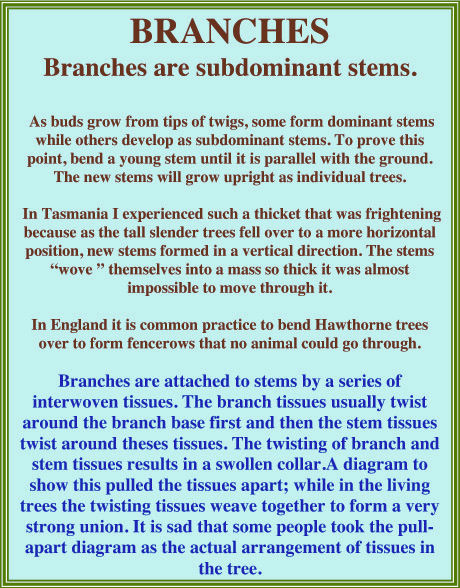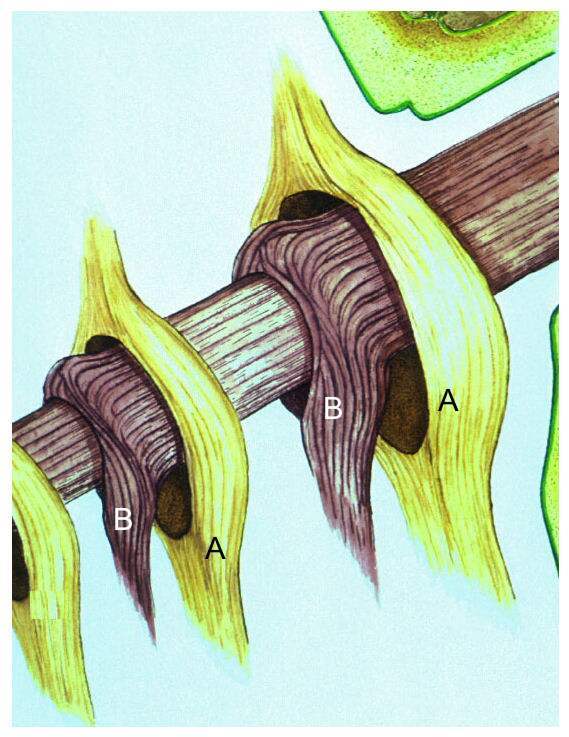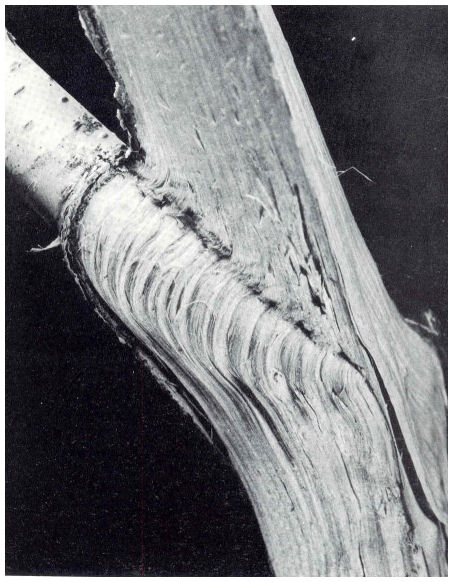
Image Source - TREES, ASSOCIATES, and SHIGO (2 CD set).

Image Source - TREES, ASSOCIATES, and SHIGO (2 CD set).

Above is a pull apart diagram of the collars. It shows two growth increments (B,A + B,A). B is a branch collar and A is a trunk collar. B will usually grow first then A will grow after B. Collectively we call these two collars the "branch collar".
Text Source - TREES, ASSOCIATES, and SHIGO (2 CD set).
A PRELUDE TO THE BRANCH
Prelude to the Branch
Tree ferns and palms have one growing point. There are always a few exceptions, but for the most part the statement is true. The palm may be thought of as one large branch. When some ancient woody plants began to form more than one branch, this had to be a monumental moment in the development of trees as we know them today. If one growing point was killed, the other growing points would continue to grow. It was a redundant system that gave the tree better opportunities to survive for longer periods, even under conditions that were not always proper for growth. The single-branched trees - palms - never "migrated" far beyond the temperate zones that had freezing periods.
In the 3-tree concept, the branch is considered tree 1. When a tree is young it is primarily a collection of branches. The trunk makes up a small portion of the young tree. As the tree grows, the trunk and woody roots increase in size, and some branches begin to die. The collection of branches on a well-defined trunk now lives as a tree 2. In tree 1 each branch produces energy for itself and some for the developing trunk and roots. As tree 2 begins to form, the ratio of energy demands between branches-tree 1-and trunks and roots, begins to change. The trunks and roots require more energy because they are larger. As some branches are not able to meet "the demands" of the enlarging trunk and roots and still have enough energy for themselves, they shed portions of themselves to survive. When the "demands" of the trunk and roots continue to increase while the branch is getting smaller, the energy source is so reduced that eventually the branch dies and is set off from the trunk by an elaborate boundary-forming process.
As many tree 2's grow, they are connected in their natural environment by root grafts or by the fungi that are associated with the many nonwoody roots; the mycorrhizae. The collections of tree 2's then gives us tree 3. Tree 3 is the community tree and each tree 2 is like a branch on tree 3.
A branch is a subdivision of a unit. A tree without branches is not a tree. A tree is a collection of branches. In a sense, each branch "repeats" or reiterates the tree. The trunk forms as portions of the branches come together. But how are these tree branches attached to the trunk? From an engineering vein, it is impossible to cantilever a horizontal beam from a vertical beam and have the horizontal beam stay on. It cannot be done. Yet the tree does it; over, and over, and over again. How?
The answer to how branches are attached to tree trunks has been the most exciting natural puzzle Dr. Shigo had ever tried to solve. We still do not have all the answers, but enough of the pieces have been put in place to see the theme of branch attachment. There are many variations that await more study.
Indeed, the branch was a major jump forward for the evolving tree. The branch increased the number of growing points. But, nothing-that we know of-in nature comes in singles. There is always another side of the subject. The other side deals with all the things that could go wrong as the branch develops, and all the things that could go wrong after the branch dies. Both situations could make conditions proper for organisms that inhabit wood. Both situations pose a potential Achilles' heel-a weak spot-that is the situation many times.
As you learn more about trees and natural systems you will see that the weak spots are always there. The weak spots are often time situations. The weak condition may last only a few minutes or a few days. The longer the weak condition lasts, the better the chances for aggressive organisms to attack. Once we have a better understanding of these potential weak spots or Achilles' heels, the more we can do to select trees that have stronger systems, or we may be able to do things that help the tree to pass through the weak period or vulnerable time much faster.
The New Tree Biology demands more than your muscles; the New Tree Biology demands your mind. It demands that you understand the zig-zig, and the zag-zag and the way natural processes go. Then you will be the best one to make decisions on how to best help trees. It is our strong belief that this is the best way - only way- to go. You know your business much better than we will ever know it. If you can add more knowledge to your training, skills, and common sense, trees will benefit; I'm sure! See - The book – A NEW TREE BIOLOGY by ALEX L. SHIGO.
Text Source - TREES, ASSOCIATES, and SHIGO (2 CD set).
BRANCHES -
One of the most important events in the evolution or development of trees was the formation of multiple growing points- branches. Palms, tree ferns, and the ancient trees had one meristem or growing point. Trees in warm climates could survive with one meristem because there was no dormant period and the major survival factor was space to grow. So, upward rapid growth had survival value. There was no room for lateral growth. As multiple meristems began to appear on trees, this gave them more opportunities to "move" into new spaces. Now space was no longer the major limiting survival factor; temperature was. The multiple meristems gave the tree more opportunities to survive as harsh temperatures killed many, but not all of the meristems. The evolution of a branch was still not that simple. The branch had to have a strong enough attachment so it would stay on the stem during winds, and now snow and ice, a new condition. At the same time, the branch had to have a way of separating itself from the stem when the branch died. So, the branch had to be strongly attached on one hand and very weakly attached on the other hand. How this dilemma was "solved" was one of the wonders of nature. The branch tissues mature before the stem tissues. The branch tissues do not grow onto the stem, but instead they turn abruptly at the base of the branch and form a ring or collar of tissues that meets below the branch. This small strip of tissues below the branch lies on the trunk, but can hardly be called a structural attachment. After the branch tissues slow their growth, the trunk tissues begin to grow and to form a ring or collar of trunk tissue over the branch collar. Every growth period the trunk collars envelop the branch collars. In a sense, the branch is really not tied onto the trunk but is held on by a series of trunk collars. Within the base of the branch a protection zone that contains antimicrobial substances begins to form as the branch dies. Branch-inhabiting organisms grow downward to the protection zone and usually stop. Decayed wood at the base of branches facilitates shedding. In conifers, protection resins are deposited in the branch corewood while the branch is alive. The resins may form outward into the branch. There is no direct, local conduction from trunk tissues above a branch into the branch. The branch receives water and elements in the pathway of tissues that form the branch collar. Water and elements are transported upward in the xylem and food made by the leaves is transported downward in the phloem. Water, elements, and food do not move from branch to branch, nor do other substances. These points are made for branches that have wood of more than one-growth-period old. Transport may go both directions in primary tissues or in tissues that are one-growth-period old.

Text and Image Source - TREES, ASSOCIATES, and SHIGO (2 CD set).
A major myth is that there are no such things as trunk and branch collars. Branch collars and trunk collars are shown to the left in paper birch. The collars are collectively called branch collars. Anyone who has split wood has seen thousands of the collars, yet some people say they do not exist. Some people have seen the pull-apart diagram of the collars and thought that that is the way they are in the living tree. Not so! In the tree the collars join and overlap as shown here.
Dictionary
MAIN PAGE
Text & Graphics Copyright © 2008 Keslick & Son Modern Arboriculture
Please report web site problems, comments and words of interest, not
found.
Contact